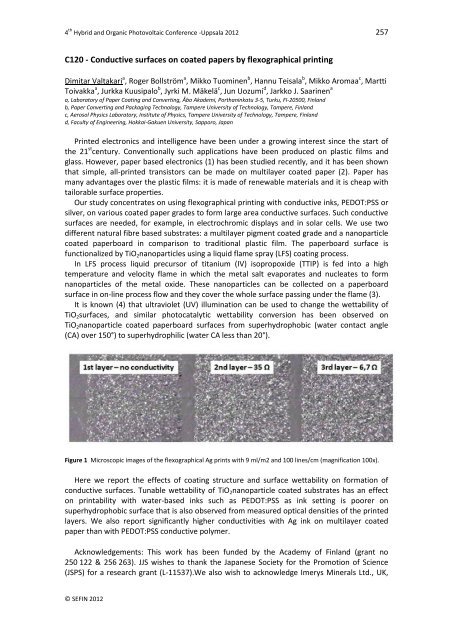HOPV12 - Blogs
HOPV12 - Blogs
HOPV12 - Blogs
You also want an ePaper? Increase the reach of your titles
YUMPU automatically turns print PDFs into web optimized ePapers that Google loves.
4 th Hybrid and Organic Photovoltaic Conference -Uppsala 2012 257<br />
C120 - Conductive surfaces on coated papers by flexographical printing<br />
Dimitar Valtakari a , Roger Bollström a , Mikko Tuominen b , Hannu Teisala b , Mikko Aromaa c , Martti<br />
Toivakka a , Jurkka Kuusipalo b , Jyrki M. Mäkelä c , Jun Uozumi d , Jarkko J. Saarinen a<br />
a, Laboratory of Paper Coating and Converting, Åbo Akademi, Porthaninkatu 3-5, Turku, FI-20500, Finland<br />
b, Paper Converting and Packaging Technology, Tampere University of Technology, Tampere, Finland<br />
c, Aerosol Physics Laboratory, Institute of Physics, Tampere University of Technology, Tampere, Finland<br />
d, Faculty of Engineering, Hokkai-Gakuen University, Sapporo, Japan<br />
Printed electronics and intelligence have been under a growing interest since the start of<br />
the 21 st century. Conventionally such applications have been produced on plastic films and<br />
glass. However, paper based electronics (1) has been studied recently, and it has been shown<br />
that simple, all-printed transistors can be made on multilayer coated paper (2). Paper has<br />
many advantages over the plastic films: it is made of renewable materials and it is cheap with<br />
tailorable surface properties.<br />
Our study concentrates on using flexographical printing with conductive inks, PEDOT:PSS or<br />
silver, on various coated paper grades to form large area conductive surfaces. Such conductive<br />
surfaces are needed, for example, in electrochromic displays and in solar cells. We use two<br />
different natural fibre based substrates: a multilayer pigment coated grade and a nanoparticle<br />
coated paperboard in comparison to traditional plastic film. The paperboard surface is<br />
functionalized by TiO2nanoparticles using a liquid flame spray (LFS) coating process.<br />
In LFS process liquid precursor of titanium (IV) isopropoxide (TTIP) is fed into a high<br />
temperature and velocity flame in which the metal salt evaporates and nucleates to form<br />
nanoparticles of the metal oxide. These nanoparticles can be collected on a paperboard<br />
surface in on-line process flow and they cover the whole surface passing under the flame (3).<br />
It is known (4) that ultraviolet (UV) illumination can be used to change the wettability of<br />
TiO2surfaces, and similar photocatalytic wettability conversion has been observed on<br />
TiO2nanoparticle coated paperboard surfaces from superhydrophobic (water contact angle<br />
(CA) over 150°) to superhydrophilic (water CA less than 20°).<br />
Figure 1 Microscopic images of the flexographical Ag prints with 9 ml/m2 and 100 lines/cm (magnification 100x).<br />
Here we report the effects of coating structure and surface wettability on formation of<br />
conductive surfaces. Tunable wettability of TiO2nanoparticle coated substrates has an effect<br />
on printability with water-based inks such as PEDOT:PSS as ink setting is poorer on<br />
superhydrophobic surface that is also observed from measured optical densities of the printed<br />
layers. We also report significantly higher conductivities with Ag ink on multilayer coated<br />
paper than with PEDOT:PSS conductive polymer.<br />
Acknowledgements: This work has been funded by the Academy of Finland (grant no<br />
250 122 & 256 263). JJS wishes to thank the Japanese Society for the Promotion of Science<br />
(JSPS) for a research grant (L-11537).We also wish to acknowledge Imerys Minerals Ltd., UK,<br />
© SEFIN 2012


